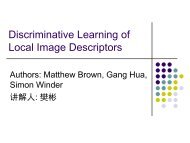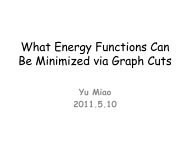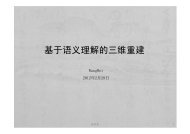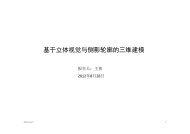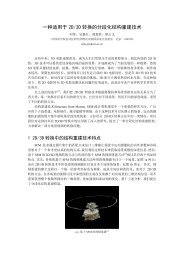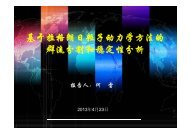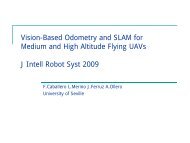Rotationally Invariant Descriptors using Intensity Order ... - IEEE Xplore
Rotationally Invariant Descriptors using Intensity Order ... - IEEE Xplore
Rotationally Invariant Descriptors using Intensity Order ... - IEEE Xplore
Create successful ePaper yourself
Turn your PDF publications into a flip-book with our unique Google optimized e-Paper software.
This article has been accepted for publication in a future issue of this journal, but has not been fully edited. Content may change prior to final publication.<br />
<strong>IEEE</strong> TRANSACTION ON PATTERN ANALYSIS AND MACHINE INTELLIGENCE 20<br />
tors (MROGH or MRRID), we can obtain five descriptors for one interest point: SR-i denotes<br />
the descriptor calculated from the ith support region and MR is the descriptor concatenating<br />
SR-1, SR-2, SR-3, SR-4. For each image pair, we respectively calculated these five descriptors to<br />
perform point matching and obtained the average recall vs. average 1-precision curves as before.<br />
The comparative results are shown in Fig. 10, in which Fig. 10(a) is the results of MROGH while<br />
Fig. 10(b) shows the results of MRRID. It can be found that SR-2, SR-3, SR-4 perform better<br />
than SR-1, butSR-2, SR-3, SR-4 perform almost as well. Thus when <strong>using</strong> a single support<br />
region, the performance of descriptor improves when the size of support region increases, but the<br />
effects become negligible after reaching a certain size. Fig. 10(a) and Fig. 10(b) demonstrate that<br />
by combining multiple support regions for descriptor construction, the performance of MROGH<br />
and MRRID improves significantly over the best performance of <strong>using</strong> a single support region.<br />
This indicates that <strong>using</strong> multiple support regions improves the discriminative ability of our<br />
proposed descriptors. For comparison the performance of SIFT is plotted too. It is worth noting<br />
that even a single region based MROGH (SR-1) is superior to SIFT while the dimension of SR-1<br />
is much lower (48 vs. 128), demonstrating the effectiveness of the proposed method. Fig. 10(c)<br />
shows the results of calculating SIFT with multiple support regions. Although the performance<br />
of SIFT is improved with multiple support regions, the improvement is much less significant than<br />
MROGH and MRRID. This is because the error and uncertainty induced by incorrect orientation<br />
estimation hamper its further improvement. In contrast, MROGH and MRRID do not have such<br />
limitations as they do not involve any orientation estimation.<br />
C. Image Matching<br />
To evaluate the performance of the proposed descriptors, we conducted extensive experi-<br />
ments on image matching. We followed the evaluation procedure proposed by Mikolajczyk and<br />
Schmid [22]. The codes for evaluation were downloaded from their website [44]. Three other<br />
local descriptors were evaluated in our experiments for comparison: RIFT, SIFT and DAISY. In<br />
our experiments, SIFT was downloaded from the Oxford University website [44] which is the<br />
same as the one used by Mikolajczyk and Schmid [22] while RIFT and DAISY (The T1-8-2r8s<br />
configuration [34] of DAISY is used.) are our own implementations. Note that the downloaded<br />
SIFT only uses one dominant orientation (the orientation corresponds to the largest peak of the<br />
orientation histogram) for each interest point. In order to be consistent with it, our implementation<br />
November 26, 2011 DRAFT



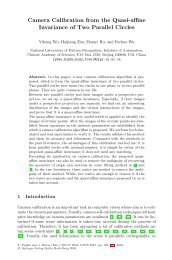
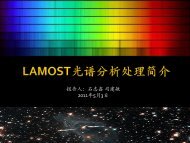
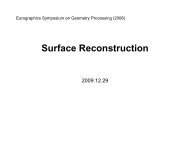
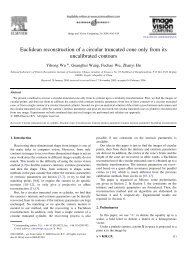
![Accurate, Dense, and Robust Multi-View Stereopsis (PMVS) [1,2,3]](https://img.yumpu.com/19388840/1/190x135/accurate-dense-and-robust-multi-view-stereopsis-pmvs-123.jpg?quality=85)
